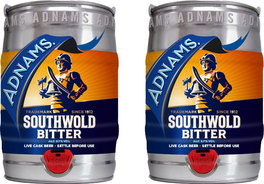ABV: 3.7%
Origin: Southwold, Suffolk, England
Website: adnams.co.uk
I’ve long regarded Adnams Southwold Bitter as one of the benchmark examples of a traditional English cask bitter, an outstanding demonstration of the genius of the best old estabished British breweries for achieving depth and complexity of flavour in a low gravity beer while retaining easy going drinkability.
Interestingly, it was only introduced in its current form as a “best” bitter in 1967, though six years later Frank Baillie in his survey of British brewing The Beer Drinker’s Companion is already describing it as “ a very distinct flavoured and popular draught bitter”. In my own early days as a real ale drinker in the late 1970s and early 1980s I looked forward to the rare occasions when it would find its way to my local free house.
Over three decades on, it’s still holding up and indeed on particularly good form in the hands of current head brewer Fergus Fitzgerald. Irish-born Fergus has proved an impressive custodian of the Southwold brewery’s tradition, while also steering it into more contemporary styles. The bitter is still brewed with strictly old school ingredients – East Anglian pale and crystal barley malts, with Fuggles the featured hop, both in a late addition and in dry hopping.
On cask in top condition, it’s a clear, deep amber beer with a bubbly white head and a delicate aroma combining chaffy light malt notes, stewed fruit and subtle spicy hops. The palate is notably dry – perhaps very slightly astringent – but develops impressive complexity, with twiggy spice, marmalade notes and a slightly salty, almost seaweedy touch. Some writers have romantically suggested a whiff of sea air from the brewery’s coastal location.
A chewy, lasting, lightly tart finish has a bit more salt alongside tobacco and more marmalade, with a distinct but controlled peppery bitterness emerging from the hops.
The bottled version, at a higher strength of 4.1%, is filtered and to me lacks the delicacy of the draught, but what really caught my attention in 2012 was the minicask version, which I discovered when researching a piece for Beers of the World about draught beer for the home. It’s essentially the same beer as the pub version, at the same ABV, but conveniently packaged for domestic use.
For those unfamilar with the format, minicasks – or easyKeg ITs as they’re termed by their German manufacturer Huber – are rugged 25cm tall waisted tinplate containers with a 5l capacity, looking much like a miniature version of a real cask stood on end, with a neat pullout tap near the base and an additional reclosable vent at the top.
They were originally intended for filtered German-style beers intended to be drunk quickly at events and parties, and the vent was provided as the simplest way to let air in so the beer could get out. But they have also turned out to be an ideal way of packaging cask conditioned beer for home use, allowing controllable venting like the bung and spile arrangement in a full sized cask.
Adnams has offered minicasks since 2010 as one of a growing number of British brewers adopting the technology to open up a new home drinking market. At first the products were very much a minor sideline, with a few filled by hand alongside conventional casks for the trade. Now demand has rocketed so much the brewery has invested in special equipment for filling them.
“It’s been phenomenal,” Fergus told me. “We sold 30,000 minicasks in 2011 and we easily expect to get past that this year. People are drinking more at home, and they’re also drinking more flavoursome beers, so we expect demand to keep on growing.”
Like their bigger brothers in the trade, minicasks come with a ritual attached, which Fergus sees as part of their charm. They need to be left to settle after transport, then vented, and left to stand for a further 24 hours before the first pint is poured. Once opened the contents should be consumed within three to five days.
“It’s an education,” said Fergus. “Having to look after a minicask helps people to understand more about cask beer as a live product, which helps their appreciation in the pub too.”
To demonstrate, he sent me a minicask of Southwold Bitter on which I lavished due care, venting it with a reassuring hiss and cooling it to something like cellar temperature with that old lo-tech standby, the wet towel.
I was rewarded with a fine looking pint sporting a creamy, lacy head, and all the chaffy freshness and spicy, fruity, marmalade-tinged complexity on the aroma that I’d expect in a pub with a top class cellar, with the smooth, gentle, easy condition of a proper cask beer.
The refreshing palate was packed with earthy, fruity flavour, leading to a smooth and lightly roasty finish, with a good balance of crystal malts and resinous Fuggles leaving lingering pepper, charcoal and even light chocolate notes.
While pub campaigners might bemoan the minicask and similar systems as yet another threat to the beleaguered on-trade, as a drinker I can’t help but be delighted that beer of such quality is now available for dispense in my own kitchen.






Glad you enjoyed the minicasks Des.
Nice to see ‘twiggy’ used in a positive sense for a change.
Thanks both for comments and thanks for supplying the minicasks Fergus. I normally see “twiggy” as positive — it seems to evoke autumnal, vegetal, slightly woody, chewy flavours.